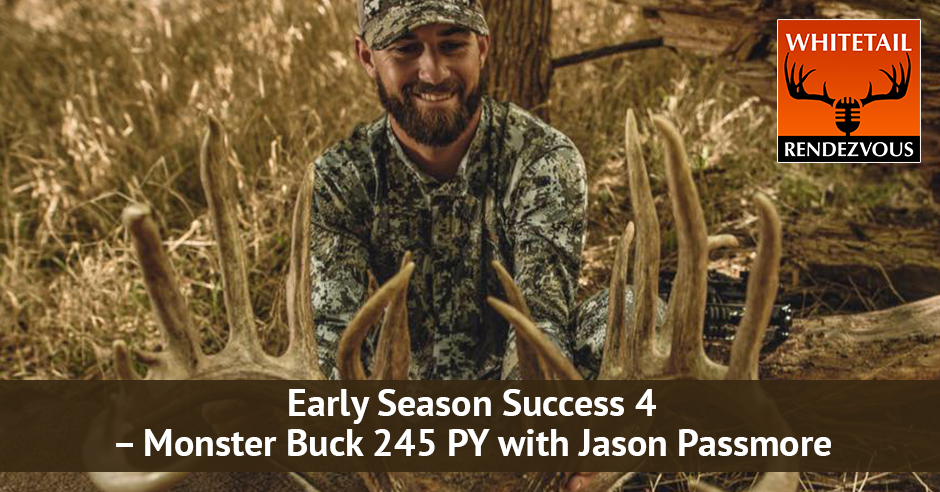
Most hunters’ dream is taking down a 200-inch DIY buck, and Jason Passmore made it real. He’s grossed out at 245. Today, we dive into everything you need to know about how he did it. As he recounts this remarkable hunting experience, learn how Jason set up on the pinch point and strategized this massive hunt. He points out that you should only hunt when the conditions are right, and shares his thoughts on where to expect a deer to come from. Moreover, Jason reveals what he wished he knew years ago that has made him a better hunter.
—
Listen to the podcast here:
Early Season Success 4 – Monster Buck 245 PY with Jason Passmore
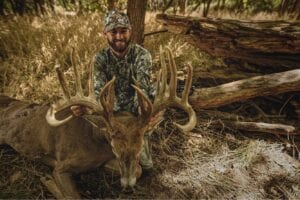
Welcome to another episode, early season success special with Jason Passmore from Emporia, Kansas. Jason did something that we all dream about in taking a 200-inch DIY buck. He’s grossed out at 245. This is an early season buck. Jason, welcome to the show. I can’t wait to hear the story. Tell us about it.
Thanks, Bruce. It’s a deer that we named Ganon. We passed him on a property that my wife and I hunt that’s been in our family for a number of years. He was probably in the low to mid 150s. We elected not to hunt the property after I’d seen him the first time because I didn’t know if I’d be able to pass him again. It’s tempting. He had a few non-typical points and a heavy deer. By letting him walk, I thought he’d get bigger, but I didn’t think it’d be to the extent that he did. He showed back up this spring. We found a shed early spring. One of my buddies that I shed hunt with found his left side. He showed back up obviously in velvet. I’ve got a pile of pictures of him in velvet. I’ve tried to get an early season pattern on him. He disappeared for a couple of weeks. I’m not sure why. It was probably when he was losing velvet. He showed back up September 3rd. His velvet was gone. He was back onto a somewhat normal routine, obviously mostly at night being a mature deer. I had him at daylight Friday, Saturday, Sunday, Monday and I killed him Tuesday evening at 6:45. We have a pretty fair amount of history with this deer. It’s the first year I’ve ever taken off this particular property and the first shooter that I’ve had since 2015 in there. Not killing the one in there before is a pretty big deal. It went to show that if you give them time, they can sure put it on. He’d blew up. Depending on what he ends up scoring, he’d put on 80 and 90 inches. It’s a pretty big deal.
That’s huge, how much bone is to grow in a matter of months.
It’s not what you expect when you let a deer walk. The whole idea is to let them grow a little bit, but something like that was definitely not expected. I’m more than happy with the outcome of it. It was unreal to watch. For us to be able to take in firsthand.
You had never taken a deer off this property, how long have you owned the property or had access to the property?
My grandparents still own it. I can’t tell you when they purchased this ground, but it’s been in their family for a generation. It’s not a big piece of property or anything like that. It’s a small 160-acre piece. It’s not overly advantageous to hunt. It’s pretty tough to hunt unless the winds are exactly perfect, which is what I had to wait for. A lot of people say, “A north wind is easy to get,” which it is late in the season, but I want to try to target a buck early. We don’t get a lot of north wind in Kansas when it’s still warm out. We caught that cold front right. It simply worked out when he was daylighting a little bit and caught the north wind on Tuesday. It made him show up roughly an hour before dark. That was why he was on his feet moving a little bit earlier because it was a fifteen-degree temperature drop that day. The wind went from southwest straight out of the north blowing pretty hard. That’s what I keyed on and went in after that.
To break it down, 160 acres is huge. How much is a wood lot or huntable versus Ag?
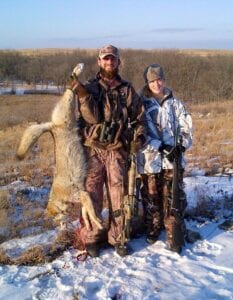
There are probably 100 acres of tillable and the rest being creek bottom and wood lot. It’s broken up into four different fields. I hunted the creek crossing is where I hung that set. I felt like the only way to kill him in that small property. There’s a pretty fair amount of pressure around it. Even though he got hard horned, he was still on a pattern. He hit two scrapes on the way to me. They’re starting to get a little bit amped up. They were on their way to get amped up. He would have left the property because it doesn’t hold a whole lot of does. When the rut would have kicked in, he would’ve been gone. I felt my best opportunity to shoot him was early and caught him on that pattern. I didn’t think he’d daylight for five days in a row. I lucked out and caught that cold front right while he was on his feet for that near a week. It got him moving a little earlier with that north wind and it helped out.
If a cold front is coming through, you’re going to get plenty of warning, call in sick, don’t show up for work, get a kitchen pass, but you need to hunt that. Cold fronts work. Why? You got barometric pressure change. You got a delta in the temperature. Typically a cold front, the wind switches up. Everything changes. It modifies behavior. Your thoughts on that?
My opinion, I don’t claim to know everything about deer hunting or anything like that, but I saw two deer that night and both were mature bucks. I was after Ganon without a doubt. The other buck got a pass, but both of them hit scrapes. They were on their feet early. Even though they were still patternable because of the early season, they’re gearing up, getting ready for rut, stuff like that. I don’t know about calling in on most days, but if you get a 15-degree temperature change and you think you’ve got a shooter daylighting, probably better make a move. I was in the middle helping one of my buddies pour concrete at 2:00 when that cold front hit. I told him he had enough help. I was headed to the tree. It worked out. He ended up getting his concrete done. I ended up getting a deer. It worked out in the end.
Let’s talk about the set. In the pictures you sent me, you can tell that it’s closer to the creek bottom. There were elevation changes. Is that a funnel or a pinch point or do you set it up because that’s where the tracks are, where the trail was?
There’s obviously pretty heavy trails that go through there. It’s broke up into four fields and the creek runs right through. Basically, there are two fields on the north side with an old railroad bed that runs northwest to southeast through it. There’s a creek crossing where the old bridge used to be. They hammer that creek crossing. It’s about right in the middle of the property. All the fields connect at the same point right there. Basically, if you set up on that pinch point where all those fields meet, it funnels everything down to one focal point. Eventually, something’s going to cross there. Whether you have a target deer or anything, you’re going to get plenty of activity if they all use the same crossing in between those four fields. I had him on camera from beans. The field that he crossed to come to me, it was wheat stubble. The field on the other side of me was beans as well. He’s probably going beans to beans. I caught him in that transition in between. They hit two scrapes on the way by. Maybe they were going to scent-check grade, maybe they were going to eat with that cold front coming in, I don’t know. I had them moving through that pinch.
Where do you hang your trail camera?
It would have been 80 yards west of me overlooking that wheat stubble field, on the plot watcher mode. I had another one on the creek crossing that ran next to that old rail bed. What all the mature deer used was that old rail bed because it has such deep ditches. They could use the rail bedsides as a travel corridor and stay down out of site all the way to the creek bed. It’s out of sight, out of mind. Every picture that I had of him consistently, especially daylight, was in those low spots where he couldn’t be seen. I had pictures of him 9:45 AM, 10:45 AM. I had two pictures of him at noon or somewhere in there. I knew he had to be bedded close by. Even for him to be on his feet mid-day, it’s still pretty uncommon. With him being able to stay concealed, it made him more comfortable. That’s where I set up that set, that crossing right there where he could stay down low.
Where was Ganon sleeping? Where was his bedding area?
From best guess, when I first saw him, he was shy of 100 yards west of me on that wheat stubble-headed east to the crossing. It’s a little further south-southwest or west-southwest than what I had him pegged to be bedded, the thickest wood lot right there on that property. He must have been somewhat close in there. It was close enough. I didn’t want to push my luck and get any further in there, but yet I wanted to be close enough to their bedding area to where they could essentially make it to me before shooting light was over. I tried to set up within inside 200 yards is what I’m getting at. It worked out.
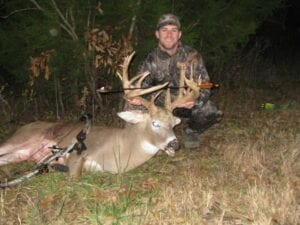
There’s a couple of things you said earlier on the railroad bed. It basically hid Ganon. He felt comfortable about walking because nobody could see him. Explain how deep that was and why it was a favorable travel corridor.
I would say it’s probably a five or six-feet deep from the top of the railway, the old rail bed, down to the main trails that run beside it. He is for sure out of sight, enough to make him feel comfortable anyway. That’s where I had a vast majority of the pictures of all deer that I get in there, but especially mature deer that are avoiding being seen. That played the biggest part of it, was they could get down out of there, out of sight.
He definitely had a sense of security. Tell me about your access because you said it pinched and it funnels. You got a north wind blowing in. You said the only way you could hunt it was on that north wind. Let’s talk about accessing that.
The property sets up more north and south than anything, with a creek running from the southwest to the northeast. Where I was set up, it hooks back and runs straight north and south right there. On the east side of the railway, the old rail bed, there’s a wet weather creek that only runs when we get a bunch of rain. I walked in from the east side of the field, off the county road, all the way into the wet weather creek bed. I got down in that where I was as low as they were, but on the opposite side of the roadbed. I followed that all the way to my tree stand down to the creek crossing where it dumps into the creek right there. It was easy to access from that point.
Don't take the easiest route where you expect a deer to come from. Share on XIf I’m thinking right, you got an intermittent seasonal creek bed. You got a railroad bed. You got a creek bed. Are they all intersecting in the same place?
Yes, except for the side that they use wasn’t ever wash out. It wasn’t ever a creek because it stayed on the east side and that’s what I took in. Theirs was basically a beat-down trail. It would run some water if we got some real heavy runoff. Aside from that, it was dry trails that connected all the fields together.
You did walk in on a seasonal creek bed though?
Yes, I did.
Lesson learned. Don’t take the easiest route, the most exposed route to your tree stand. Basically, stalk your tree stand. We all know you only can hunt your tree stand. I’m not talking a box blind or something like that over a food plot. I’m talking about where you expect a deer to come from and everything and only hunt it when the conditions are right. You’ve got to make yourself do that. I don’t care what’s happening. You’re going to do that because if you do that, you’re going to have success.
What I waited for was literally the perfect conditions. Even with the north wind, I was a little bit concerned. I was pretty close to getting it down when it started swirling because it was blowing so hard. It was wrapping around the east side of the trees and pushing it out west. I was worried that I was going to get winded. A couple of my buddies that I texted, they said, “If you’re going to wing it, now is the time to do it because hopefully, you won’t blow him out or if you do, there’ll be back since it’s still early in the season.” I decided to set it anyway. Once I got in there, close to my set, you could see that the wind was blowing down that railway with that hard north wind. It would push my scent far enough south with that north wind that I didn’t think that I was going to be affected by it.
You had a feeling that when the rut comes, he was gone because there was not a lot of does in the area. That’s part of why deer disappear later October or you have lockdown periods or whatever you want to call it. They disappear because they go out and find the does. It might not be on your 40, 80, 160 or whatever. They’re gone because they got one thing in mind and that’s breeding. Jason was hunting Ganon’s home turf. He would come back there after the rut. He might go five miles from that. Your thoughts on that, Jason?
The spot where my buddy found his shed was half to maybe a mile north of where I got a shot at him. That’s usually where he would travel to during the rut because they hold so many more does. We have a few resident does, but it’s not a lot. Most of the mature bucks would venture out of our property onto the neighbors. I figured that was the best time to get a shot at him while he was on a pattern instead of running around chasing.
What do you wish you knew several years ago that would have made you a better hunter?
I didn’t start hunting in the early season. This is the first buck I’ve killed in September by attempting to pattern. The last few mature bucks that I’ve killed were in October. Before that, I was like every other starting-out whitetail hunter. I thought the only way to kill a big deer was during the rut. If you have one that you can get patterned and you can make a legitimate move on them, early season is the time to do it now. If there was one thing I could take away from that, that’s what it would be.
Thanks for that. I appreciate that. You got so many nuggets because you’re hunting unpressured deer, for the most part. The neighbors are pushing them, maybe or maybe not. When I think about your set up and how you did it, it’s a remarkable feat to take a once-in-a-lifetime buck. Maybe you’ll do it next year. I have no idea. What a thrill, what an honor, what a privilege to mix it up with a buck of that stature and then to harvest him says a lot about your abilities. It’s well done.
Thank you. I appreciate that. It’s hard to believe I wasn’t nervous or anything. Even when I saw him closing the distance on that field coming to me, it wasn’t until after the shot when I lost it. I hung my bow up right away, sat down, took it in after that as best I could, and obviously backed out. I am fully appreciative of the opportunity to even be in that situation. I’m glad that I could hold it together up until that point.
How far did he go?
It’s 80 yards.
Did you double lunge him? Tell me about the shot.
When he first came out, I lost him when he came across the field. The other mature buck that was with him kept looking back. I knew he was there somewhere, at least, I thought he was. He took off trotting back to where Ganon was. All of a sudden, I look over and Ganon is standing right there in the middle of the trail. He walked out of some tall grass that is on that side of the rail bed. He was at fifteen yards at that point. I didn’t have any shooting lanes. I didn’t have a shot. I had to wait for him to clear. Although I’m sure it wasn’t very long, it seemed like forever. He took a few steps, maybe fifteen yards north of where he had stepped out at and stepped into an opening. I didn’t have to stop him or anything. He stopped on his own, slightly quartering away, so I stuck it in a little bit further back on the ribs and went down through both lungs and out the front shoulder on the left side.
He jumped back in that tall grass and headed back south. Instead of getting down and getting my arrow, I waited a few minutes in the stand. Instead of going down and getting it at that point, I backed out because the wind was blowing so hard. I couldn’t hear him crash. Everything this time of year is overgrown. I couldn’t see him if he went down. I went back to the truck, took my pack back and took my bow back. I walked the long way around the edge of the property and glassed back out in the fields to see if he was laying out there or even standing out there. I couldn’t see him.
I called a couple of my buddies. I called my wife. We decided that we thought it’d be a better plan to wait two hours. We went in a little after 8:45 and picked up the blood. One of my buddies who’s color blind is the one that found the blood. The rest of us were struggling and anxious to find him. Once we slowed down, stayed on blood, it took us right to him, 80 yards. He bled out both sides well. He’d been dead for a long time. He was already stiff when we got there. Two hours was probably extreme, but it wasn’t a risk I was willing to take at that point.
“Ganon,” how did he get that name?
The water system that he’s on. There’s a creek system in there that’s the name of it. I don’t know why. I called him that one time and it stuck. That’s what we called him was “Ganon.”
Only hunt a deer when the conditions are right. Share on XFor our audience, I know you got him green scored. Let’s talk about what he had on his head.
A lot more than we anticipated. He was maybe 155, low 50s, maybe mid-50s. This spring we knew he was going to be something special. He looks so big and velvet. After he had shed his velvet, I thought there was a chance that he would break 200, but I didn’t think he would be much over that. There was obviously absolutely no grounds shrinkage whatsoever. A couple of guys that were there, they’re like, “He’s going to go 220.” Another guy, “It’s 225.” I was thinking, “Maybe he’ll go 215 to 220.” That night, my buddy Adam Rottler and another buddy Ryan White taped him out while we were standing around talking and goofing around. They came up with 241. I was like, “That’s not even close.” I know another guy that’s pretty efficient at scoring. He put tape on him again and got 245 and four-eights. We scored him three different times and got 245. That’s what he’ll start out at. We’ll see after 60 days where he’s at. He is a main frame 7×7 with 42 inches of extra. Even at that rate, he was only eleven inches difference from side-to-side, eleven inches in deduction. He was 245 and netted 234.
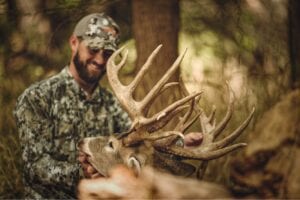
Hopefully, I can put my hands around his head some time that I’m traveling through. Jason Passmore, thank you so much for the privilege of hearing your story here on the show about Ganon, the monster buck from Kansas. Once in a lifetime, 99.9% of whitetail hunters in the world will never see if a free-range buck like that. Congratulations. Enjoy it. As you grow older and the kids grow older and you’ll sit back with your wife, you’ll look back and marvel at appropriate that substance. Well done.
I appreciate that. My wife and I said we never thought that we’d break the 200-mark. It shows you that any deer can put it on, but the genetics have to be there. I flat out got lucky that deer had it. It could happen. We never thought it would. I sure never thought I’d break the 200-mark. I was fortunate that I’m at the right place at the right time.
With that, in behalf of hundreds of thousands of readers across North America, Jason Passmore and the Ganon buck, thank you so much, sir.
Thank you.
